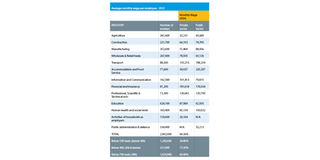Premium
Inside the big payslip lie by Kenya Kwanza

President William Ruto views a market model as he launched the construction of the Embu modern market in Embu County on May 26, 2023. He was in the town to launch several projects ahead of Madaraka Day national celebrations, which will be held in the town.
Nearly two-thirds of formal workers in Kenya take home less than Sh50,000 monthly, even as the government pushes on with a strategy to squeeze more from their salaries.
Despite data indicating low salaries, President William Ruto has been aggressive on why the “people with payslips” are privileged and must contribute to the employment of jobless Kenyans through his proposed Housing Fund in the Finance Bill 2023, which recommends a three per cent levy on salaries.
But as data by the Kenya National Bureau of Statistics (KNBS) shows, of the three million Kenyans employed in the formal workforce, 1.82 million workers (60.5 per cent) earn below Sh50,000. More than half a million workers, 17 per cent of Kenya’s formal workforce, earn below Sh30,000.
The government has been bullish on several policy changes targeting their payslips, despite a high cost of living that has left their disposable incomes depleted, and more of the middle-income group sliding back into poverty.
“I’m saying that the people with payslips should contribute something for us to plan the employment for those of you without a payslip. The workers don’t want to be deducted because they want you to stay in the streets,” the President said during a recent event in Busia.
The President argues that formal workers earn because the unemployed pay taxes, ideally indirect taxes when they consume goods and services.
“If you (the unemployed) are supporting us by paying our salaries of teachers, doctors, MCAs, MPs and the President, where is the mistake in deducting three per cent of our salaries to create jobs for you?” he said.
And at a recent event in his Kikuyu Constituency, Majority Leader in the National Assembly Kimani Ichung’wah continued on the same thread when he said the few salaried people who were supposed to pay to build houses and create jobs for the unemployed were inciting the majority.
Salared Kenyan woes
This potentially means that, should the Bill pass, a salaried Kenyan could be forced to contribute to the fund to benefit someone in business or the informal sector who makes much more money per month.
Data on earnings shows the government’s entrenched invasion of payslips puts more pressure on the earners generally categorised as the middle class, as growing deductions meet high commodity prices and stagnated salaries.
Opposition leader Raila Odinga has previously criticised the increased deductions that, he says, are leaving workers with less disposable income that could affect their dependants.
“The shock will be felt down the chain. Typically, a single payslip supports entire villages and communities in Kenya,” he said.
“As Kenya Kwanza reduces the availability of local disposable income, it is inadvertently reducing local demand for goods and services.”
The Economic Survey 2023 shows that by last year within 13 industries contributing over 96 percent of the formal employment in Kenya (2.9 million jobs), over 62 percent of the workers earned an average basic salary below Sh70,000 monthly, which reduces to less than Sh50,000 when taxes and statutory deductions are deducted.
At least 1.2 million of the workers (40 percent of Kenya’s formal workforce), earned below Sh40,000 after the deductions.
The Central Bank of Kenya (CBK) classifies the middle-income group as households spending between Sh46,355 to Sh184,394 per month in Nairobi. Any household spending below this category is classified as lower income.
“Nairobi Lower Income Group: Households spending Sh46,355 or less per month (constituting 70.89 percent of all households in Nairobi). Nairobi Middle Income Group: Households spending between Sh46,356 up to and including Sh184,394 per month (constituting 25.58 percent of all Nairobi households),” the CBK says in its latest monthly economic indicators report in March this year.

The measure CBK used this year is the same as the one used a year prior with regard to spending power as a measure of one’s social class, but there have been several factors affecting households’ spending power over the past year.
KNBS on Wednesday, for instance, reported that in May, inflation— commodity prices during the month as compared to their prices in May 2022— rose to eight per cent, from 7.9 per cent in April 2023.
Inflation lowers households’ purchasing power, especially when earnings stagnate or grow at a slower rate.
This captures the pressure that households have continued to face as food and other household commodity prices keep rising.
“Nominal average earnings in the modern sector per person increased from Sh827,300 per annum in 2021 to Sh865,600 per annum in 2022. Real average earnings per employee decreased by three per cent to Sh696,800 per annum in 2022,” the 2023 Economic Survey stated.
Raising deductions
But the government has been unforgiving on salaried people employed formally, raising deductions on salaries through taxes, levies, and other deductions, and still proposing more.
The government in February, for instance, raised the National Social Security Fund (NSSF) contributions from a flat Sh200 monthly to six per cent of a worker’s salary, where many now pay Sh1,080.
It has also proposed raising the National Health Insurance Fund (NHIF) on workers to 2.7 per cent of salary. Many have been paying about Sh1,500.
With more deductions in the government’s pursued strategy of squeezing the working to facilitate job creation for the unemployed, it will continue to be a hard life for the “people with payslips”.
Among the sectors analysed by the Sunday Nation, which constitute 96.3 per cent of the 3.015 million formal workers in the country by last year, include agriculture, manufacturing, construction, education and wholesale, and retail trade.
Average earnings in the entire agricultural sector fall Sh30,000 and below monthly, average salaries for nearly 300,000 workers in the private manufacturing sector are below Sh40,000 and average earnings for over 400,000 teachers in public schools are below Sh50,000.
“Employment in the informal sector which remains the main source of employment for the working population rose by 4.6 per cent to record 16 million jobs.
“The informal sector created 702,900 new jobs, which constituted 86.1 per cent of all new jobs created outside small-scale agriculture and pastoralists activities,” the Economic Survey stated.
The government has, however, continued to hammer people in the formal workforce more with taxes and deductions, unable to innovate a way to tax the informal workers.





